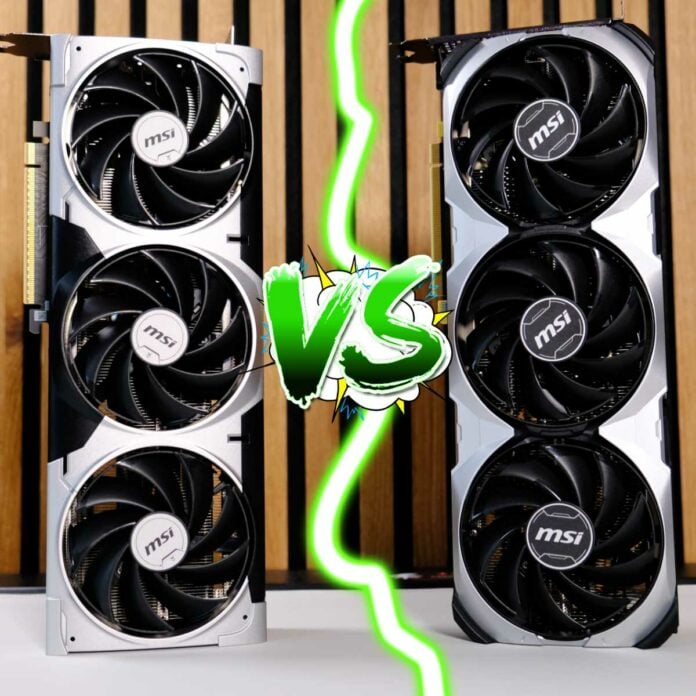Just over a year since Nvidia gave GeForce RTX 4070 Ti the Super treatment, RTX 5070 Ti is here to take its place in the midrange market. It promises performance upgrades alongside support for the full DLSS 4 suite, including Multi Frame Generation, which could come together in a spicy generational improvement.
Although Nvidia is keen to show off all RTX 5070 Ti’s improvements against the base RTX 4070 Ti, RTX 4070 Ti Super proves the more appropriate comparison. Not only did the Super model outright replace the vanilla SKU but its specs clearly laid the ground for its newly launched successor as should become plain.
Specs
At first glance, GeForce RTX 5070 Ti and 4070 Ti Super are eerily similar graphics cards. Both sport GPUs manufactured via TSMC’s 4N process, namely GB203 and AD103 respectively, and are near identical in size (378mm² vs. 379mm²). Though closely related, there are numerous architectural characteristics that separate them alongside other differences in specification.
| RTX 5070 Ti | RTX 4070 Ti Super | Ratio | |
|---|---|---|---|
| Released | Feb 2025 | Jan 2024 | – |
| Codename | Blackwell | Ada Lovelace | – |
| GPU | GB203 | AD103 | – |
| Process | TSMC 4N (4nm) | TSMC 4N (4nm) | – |
| Transistors | 45.6bn | 45.9bn | 0.99 |
| Die size | 378mm² | 379mm² | 1.00 |
| CUDA cores | 8,960 | 8,448 | 1.06 |
| Base clock | 2,300MHz | 2,340MHz | 0.98 |
| Boost clock | 2,452MHz | 2,610MHz | 0.94 |
| FP32 Boost TFLOPS | 43.9 | 44.1 | 1.00 |
| SM count | 70 of 84 | 66 of 80 | 1.06 |
| RT cores | 70 (4th Gen) | 66 (3rd Gen) | 1.06 |
| RT TFLOPS | 133.2 | 102 | 1.31 |
| Tensor cores | 280 (5th Gen) | 264 (4th Gen) | 1.06 |
| FP16 Acc TFLOPS | 351.5 | 320.8 | 1.10 |
| ROPS | 96 | 96 | 1.00 |
| Memory | 16GB | 16GB | 1.00 |
| Memory type | GDDR7 | GDDR6X | – |
| Mem. clock | 28Gb/s | 21Gb/s | 1.33 |
| Mem. interface | 256-bits | 256-bits | 1.00 |
| Mem. bandwidth | 896GB/s | 672GB/s | 1.33 |
| Board power | 300W | 285W | 1.05 |
| Launch MSRP | $749 | $799 | 0.94 |
The most notable advantages GeForce RTX 5070 Ti boasts over RTX 4070 Ti Super stem from its RT and Tensor cores. These subcomponents contain far more horsepower than prior generation designs, greatly boosting ray tracing frame rates and deep learning performance. They’re greater in quality but also in number too. As a result, FP16 TFLOPS skyrockets jumps by 10% and RT TFLOPS increase by 31%.
Nvidia mirrors much of RTX 4070 Ti Super’s memory configuration for GeForce RTX 5070 Ti. Each graphics card features a 256-bit interface and a 16GB VRAM buffer but the latter pixel pusher enjoys an upgrade to GDDR7 modules. Their 28Gb/s clock lifts total bandwidth up to 896GB/s, marking a 33% increase relative to its predecessor’s 672GB/s.
Power budget is up by 15W, to a total of 300W on GeForce RTX 5070 Ti. It’s an easy change to stomach given what this card accomplishes with more watts behind it.
Lastly, GeForce RTX 5070 Ti carries an MSRP of $749, down $50 from RTX 4070 Ti Super’s launch price. I’m happy to see Nvidia reduce the cost of its graphics cards but availability of models that adhere to MSRP is unfortunately slim. Team Green discontinued the prior generation pixel pusher some time ago and it’s holding its value quite well on the used market, likely in light of RTX 50 Series stock issues.
Performance
GeForce RTX 5070 Ti and RTX 4070 Ti Super have spent a fresh stint in the Club386 7950X3D test bench to eliminate any variables bar the graphics cards themselves. Both pixel pushers are rocking the most GeForce Game Ready drivers available on a Windows 11 24H2 installation.
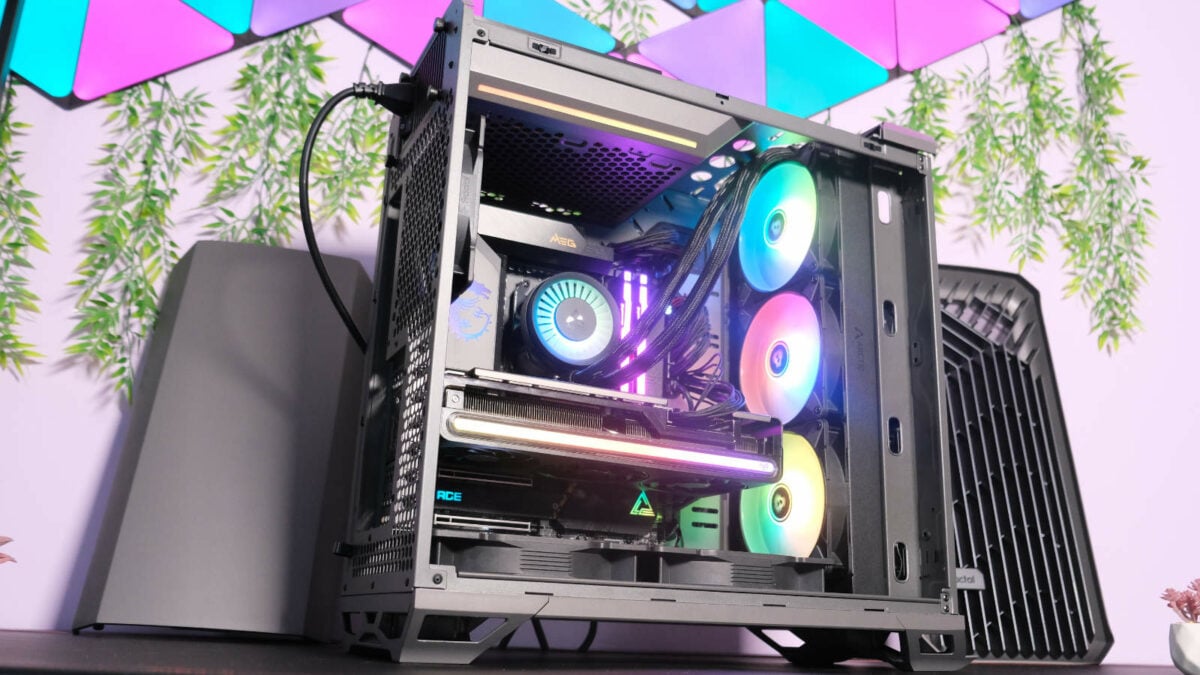
Our 7950X3D Test PCs
Club386 carefully chooses each component in a test bench to best suit the review at hand. When you view our benchmarks, you’re not just getting an opinion, but the results of rigorous testing carried out using hardware we trust.
Shop Club386 test platform components:
CPU: AMD Ryzen 9 7950X3D
Motherboard: MSI MEG X670E ACE
Cooler: Arctic Liquid Freezer III 420 A-RGB
Memory: 64GB Kingston Fury Beast DDR5
Storage: 2TB WD_Black SN850X NVMe SSD
PSU: be quiet! Dark Power Pro 13 1,300W
Chassis: Fractal Design Torrent Grey
GeForce RTX 4070 Ti Super remains a capable graphics card for UHD gaming and RTX 5070 Ti shares this quality. Both are a dab hand at high-refresh rate QHD and FHD experiences too, and you’ll find benchmarks covering all three resolutions below.
Application and AI
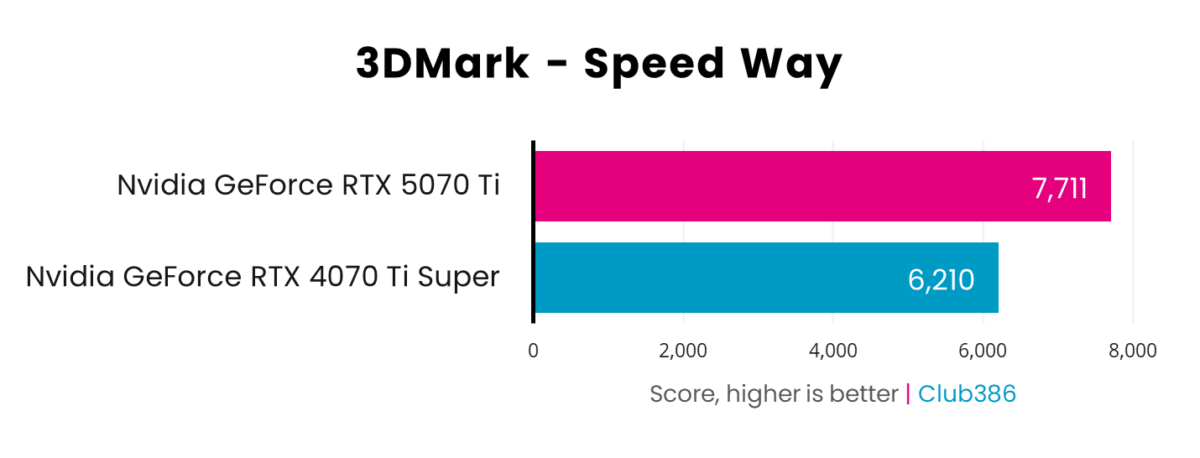
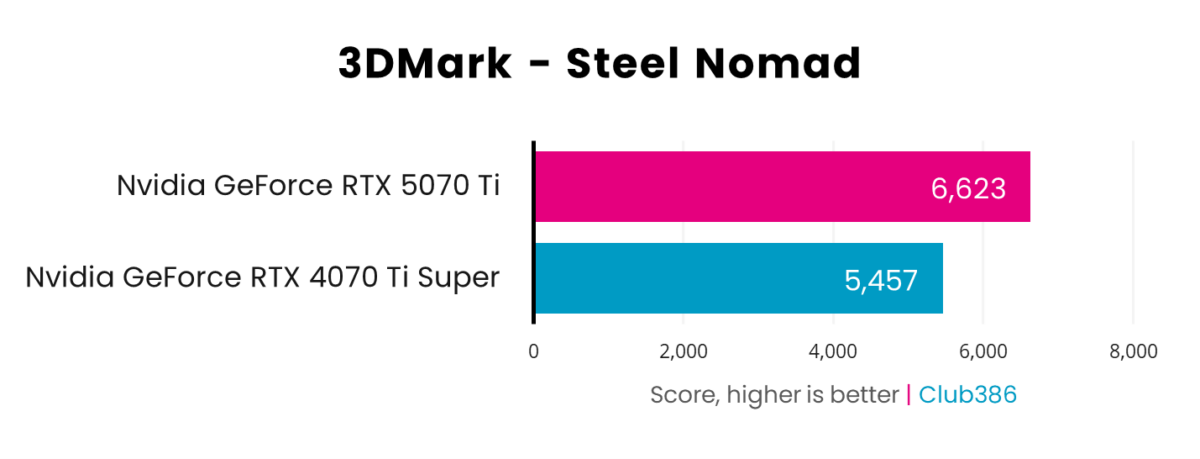
3DMark Speed Way and Steel Nomad scores indicate GeForce RTX 5070 Ti delivers a welcome generational uplift in both ray traced and rasterised rendering, to the tune of 24% and 21%, respectively.
Fourth generation ray tracing cores undoubtedly account for the majority of GeForce RTX 5070 Ti’s lead over RTX 4070 Ti Super’s third gen offerings. Having a greater number of the things under its belt doesn’t hurt either. The card also also boasts more CUDA cores to push rasterised performance further. However, a sizeable boost in memory bandwidth is undoubtedly freeing up more room to push more frames at Steel Nomad’s demanding 4K resolution.
As a reminder, 3DMark’s synthetic benchmarks don’t reveal real-world performance but provide a useful guiding star to understand the capabilities of both graphics cards.
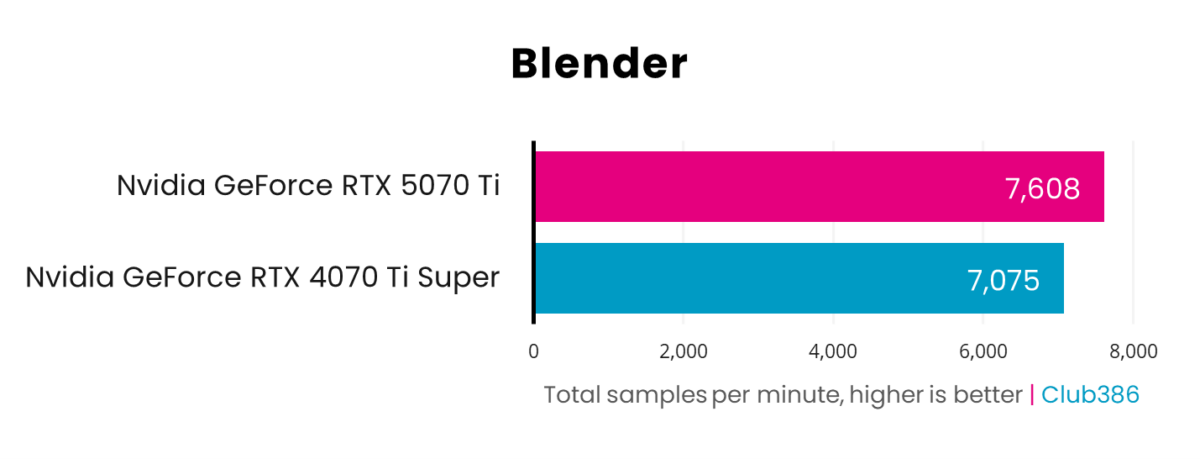
Improvements in Blender from GeForce RTX 5070 Ti are less impressive, clocking in at a measly 8%. There’s no bump in NVDEC to fall back on to improve its value in production workloads either, unlike RTX 5080.
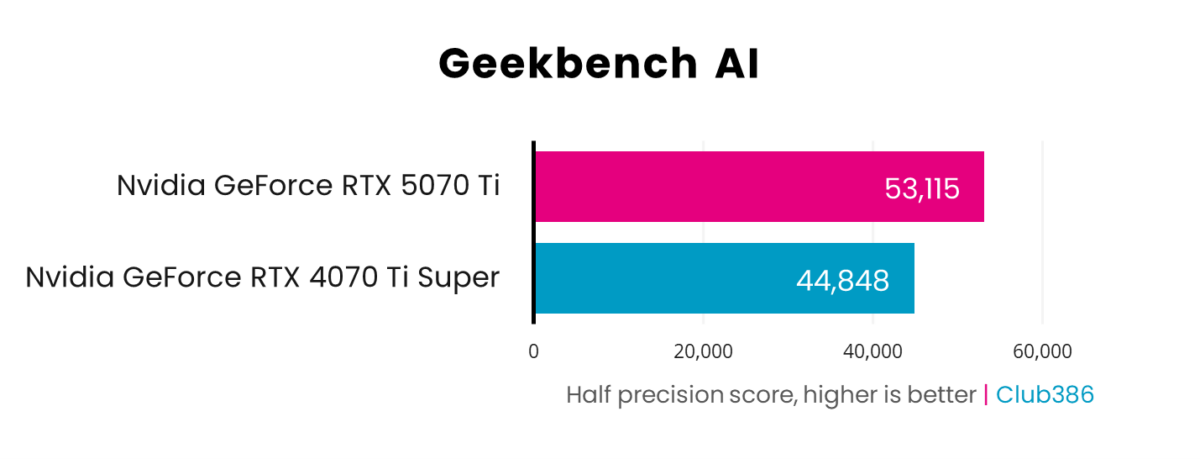
Fifth generation Tensor cores push GeForce RTX 5070 Ti ahead of its predecessor by 18% in Geekbench AI. It should come as no surprise that FP16 performance is much higher here taking into account Blackwell’s superiority over in the enterprise AI market.
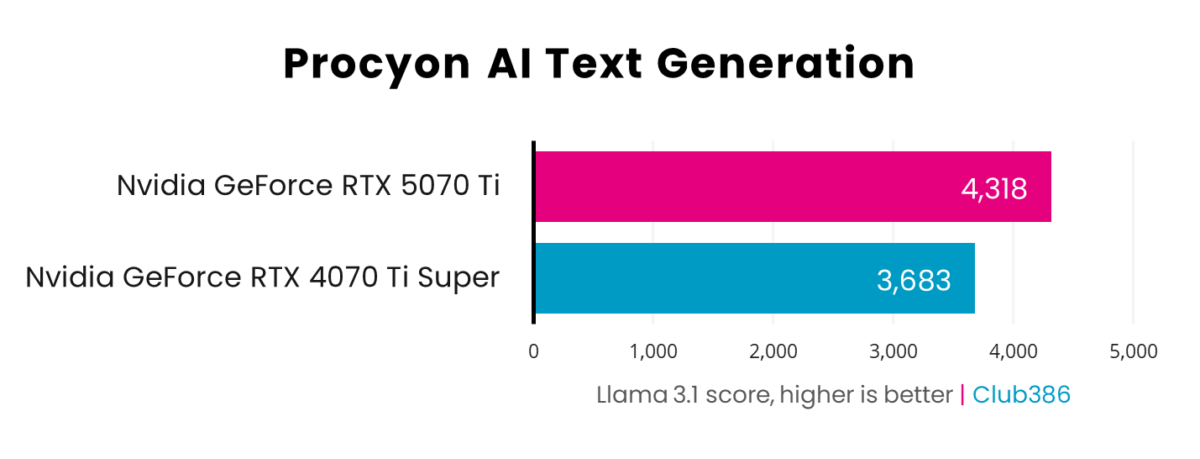
Large language model (LLM) performance is naturally better on GeForce RTX 5070 Ti than RTX 4070 Ti Super by a significant margin too. Running Procyon’s AI Text Generation benchmark, it leads its forebear by a respectable 17%.
Gaming
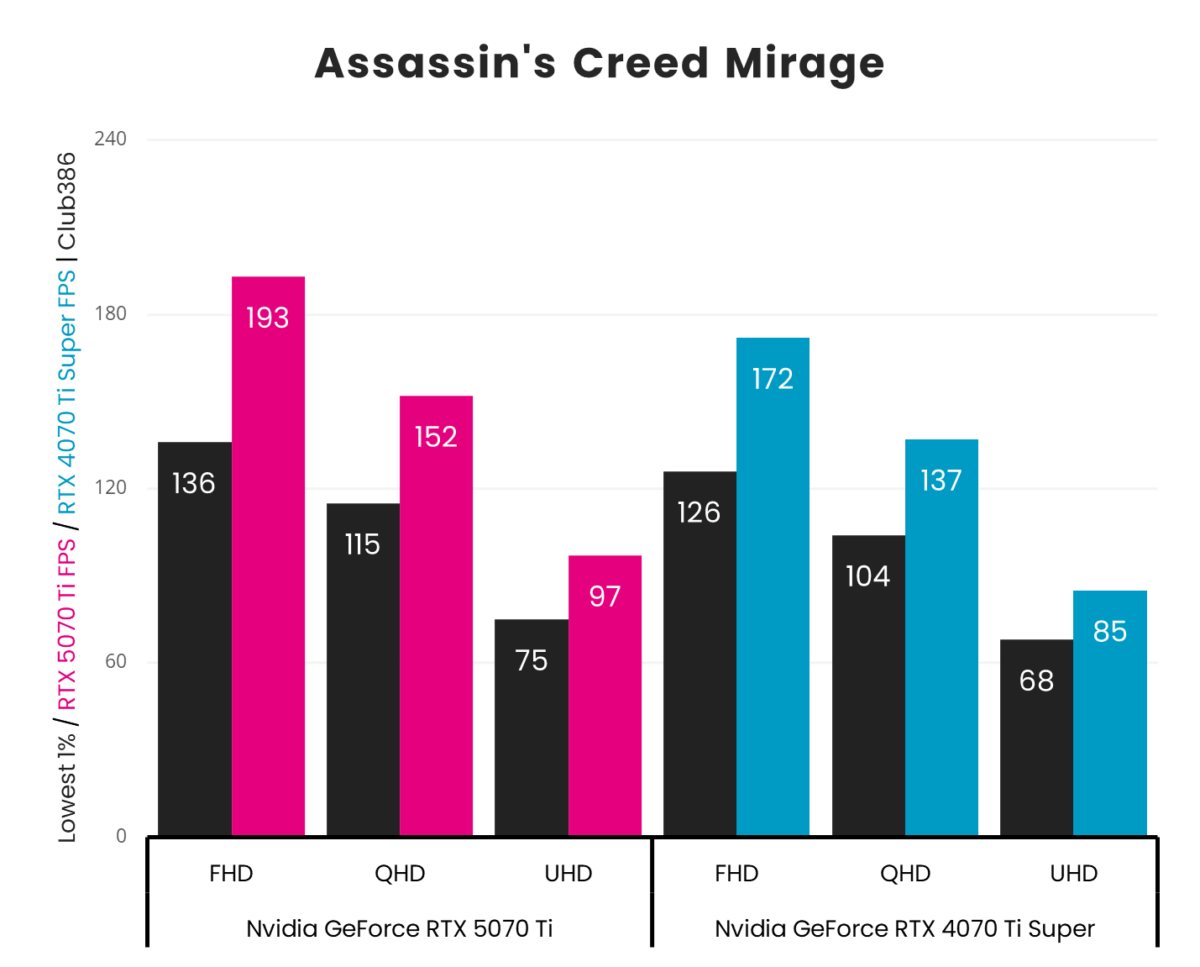
Staring with a bout of rasterised rendering through Assassin’s Creed Mirage, GeForce RTX 5070 Ti performs mildly better than RTX 4070 Ti. Performance at FHD rises 12% gen-on-gen, remaining fairly static at QHD with an 11% bump, before a small increase to 14% at UHD.
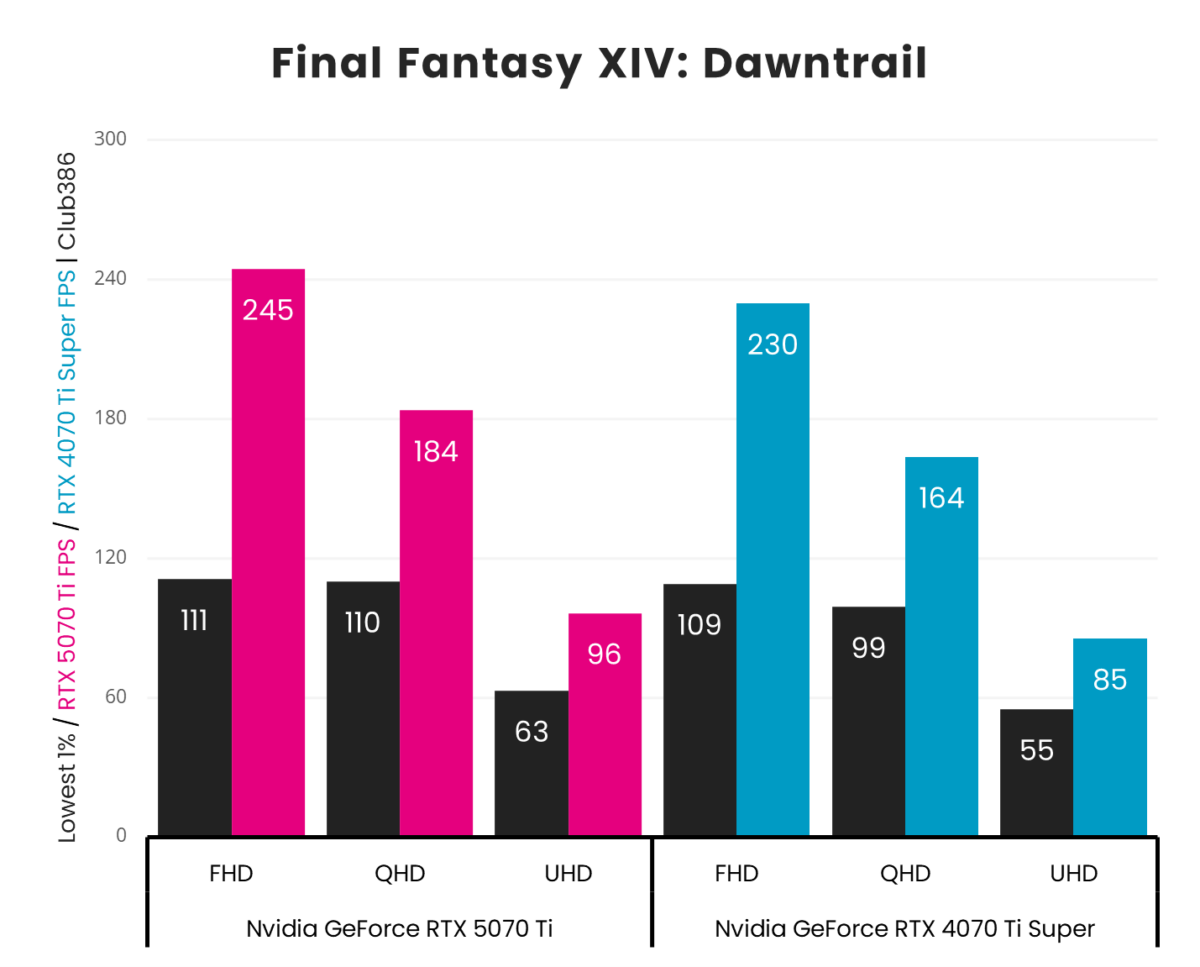
Final Fantasy XIV: Dawntrail doesn’t inspire further excitement for GeForce RTX 5070 Ti to deliver sizeable gains over RTX 4070 Ti Super. Results are rosiest at QHD and UHD, with 12% and 13% improvements a pop, but fall to a disappointing 7% at FHD. Higher frame rates on beefier graphics cards prove this isn’t the game encountering a CPU bottleneck and what’s here instead is all GPU-related.
This trend of better performance at higher resolutions continues in other titles using rasterised rendering. Much as it’s clearly capable of producing pleasing frame rates at FHD, the value of the card is much greater at QHD and UHD relative to RTX 4070 Ti Super.
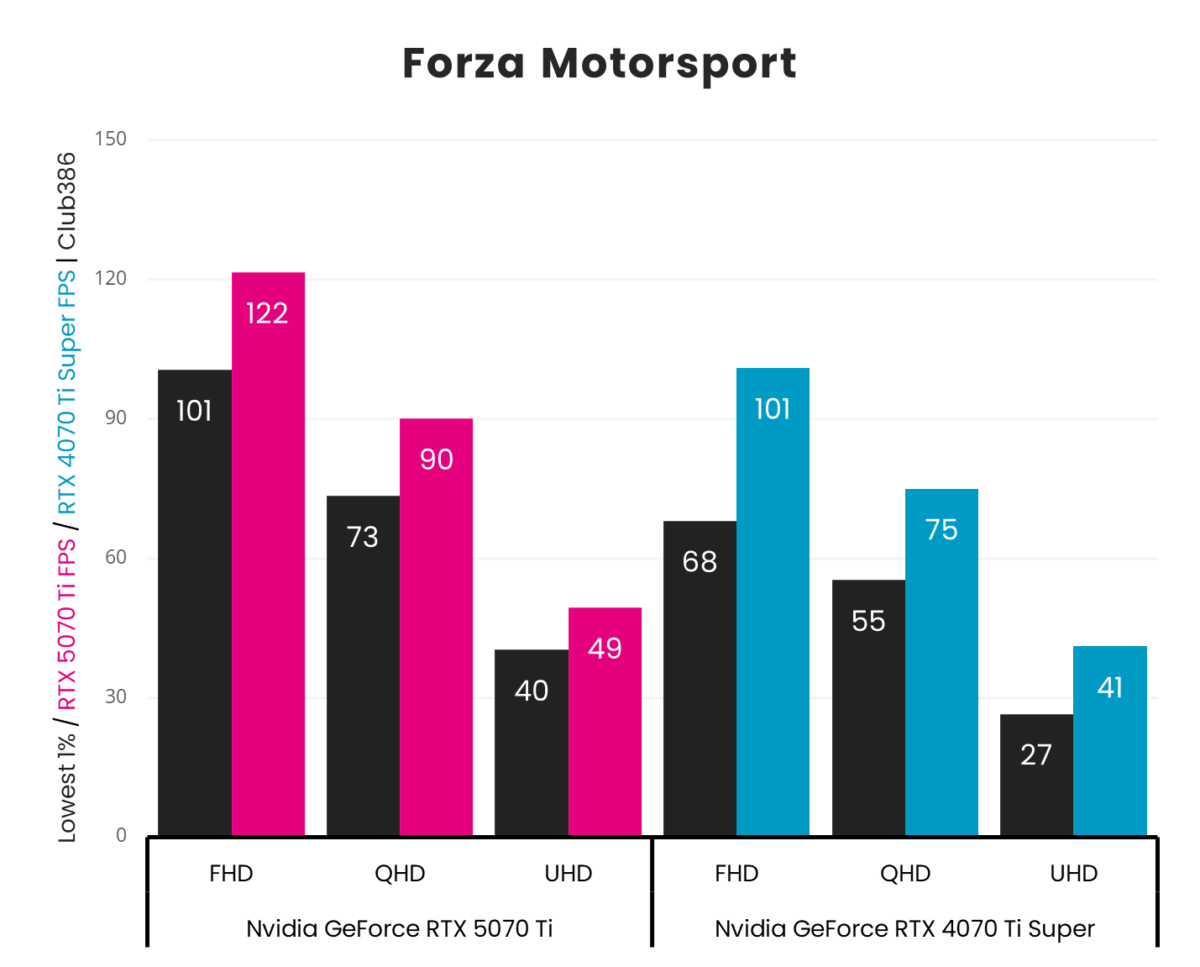
Now we’re talking; 20% uplifts at minimum across all three resolutions. GeForce RTX 5070 Ti delivers a welcome boost on the ray traced tarmac of Forza Motorsport, managing a whopping 122fps at FHD to RTX 4070 Ti Super’s 101fps.
QHD sees average frame rates rise to 90fps on GeForce RTX 5070 Ti but seeing 1% lows increase to 73fps from the prior generation’s 55fps pleases me greatly. There’s not quite enough horsepower in Nvidia’s latest ray tracing engines to make it to the 60fps finish line at native UHD but that’s nothing a touch of DLSS can’t fix.
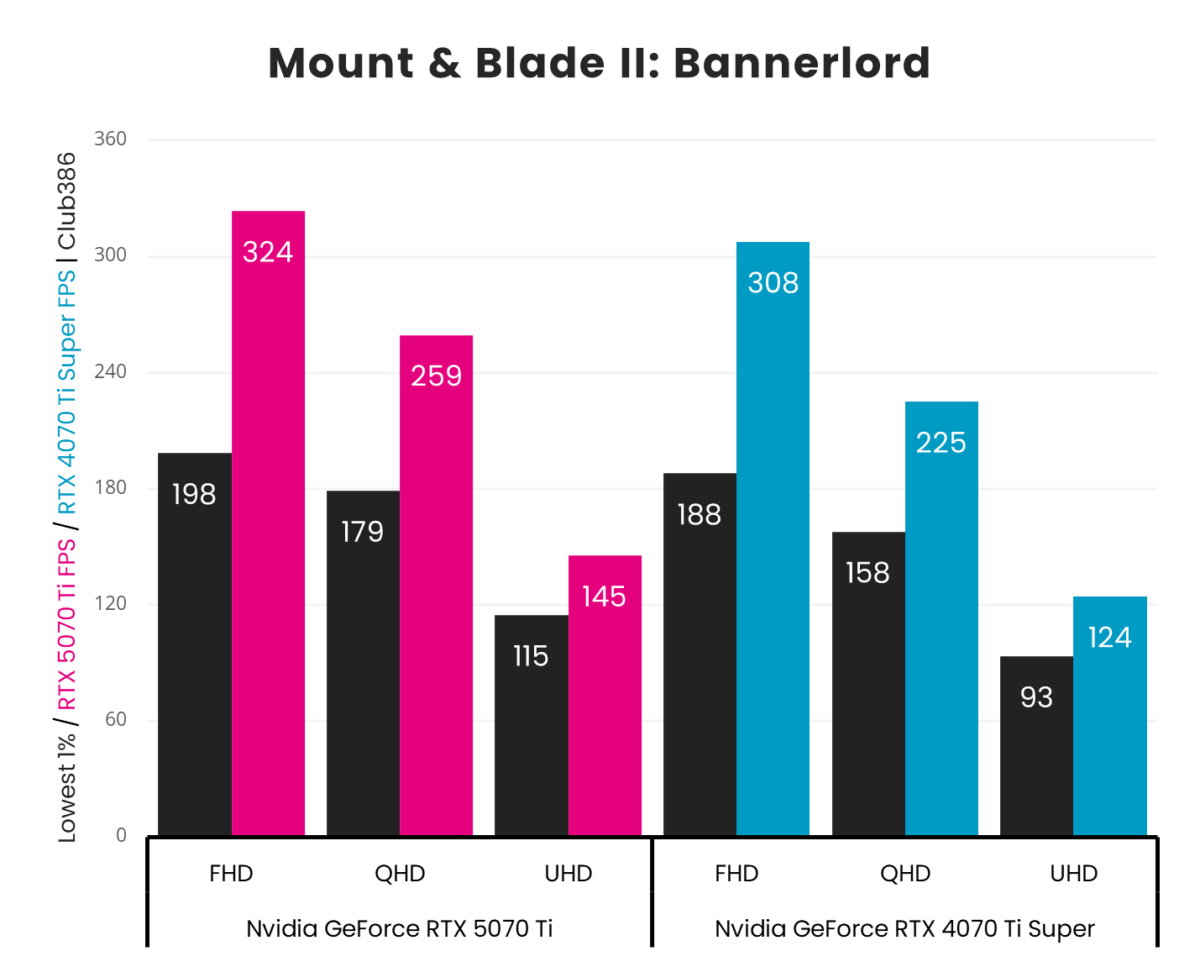
Mount & Blade II: Bannerlord runs excellently on both GeForce RTX 5070 Ti and RTX 4070 Ti Super. This is to former’s detriment at FHD with 5% separating its from its predecessor. Thankfully, the gap widens considerably to 15% at QHD and 17% at UHD, echoing the performance pattern established earlier with FFXIV.
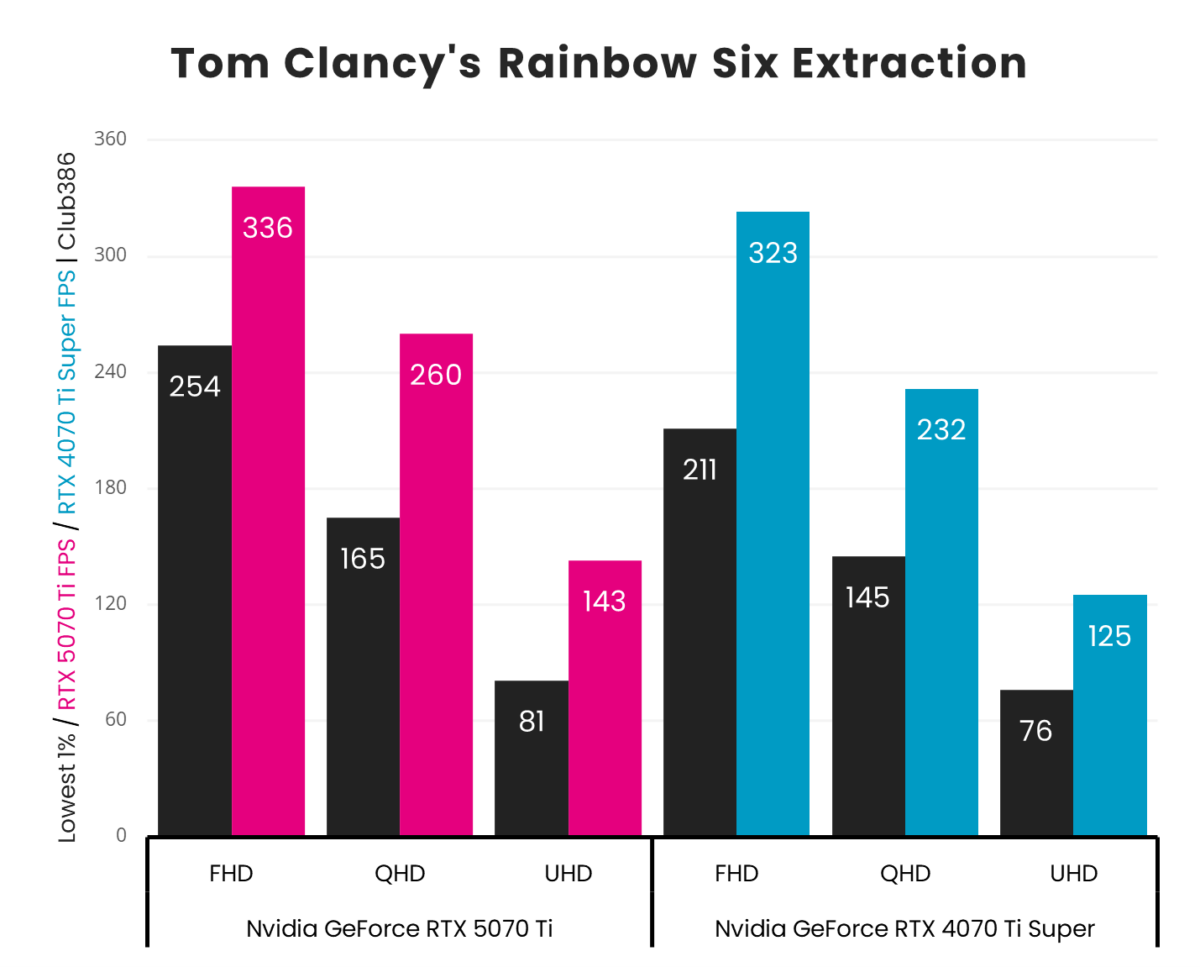
Like Mount & Blade and FFXIV before it, GeForce RTX 5070 Ti turns in better improvements over RTX 4070 Ti at UHD and QHD, 14% and 12% respectively, than it does FHD which totals at a measly 4%.
Adjacent to performance, it’s important to note that GeForce RTX 5070 Ti holds the advantage of supporting Nvidia Reflex 2 in compatible titles. Team Green says it plans to bring the feature to older generation cards like RTX 4070 Ti Super but there’s no word on when exactly.
DLSS vs. FSR
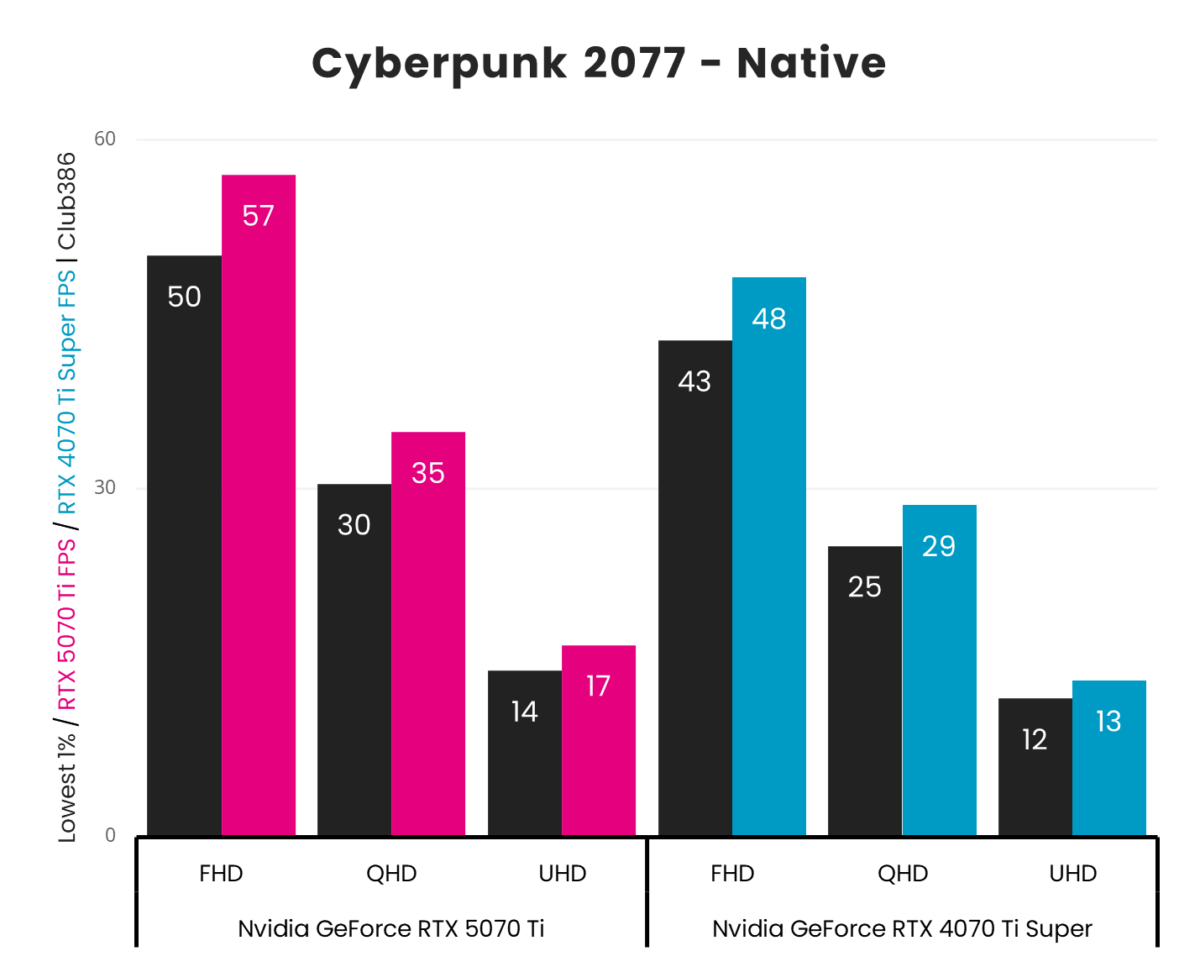
Pushing each card’s rendering capabilities to the metal via Cyberpunk 2077’s RT Overdrive preset paints GeForce RTX 5070 Ti in a generally favourable path traced light. Neither it nor RTX 4070 Ti Super push past the 60fps at native FHD, but the Blackwell newcomer does come agonisingly close with a 57fps average, making for a 9fps (19%) generational uplift.
Jumping up to QHD, GeForce RTX 5070 Ti punches north of 30fps and offers a 21% increase over RTX 4070 Ti Super performance. However, this amounts to a a mere 6fps bump in real terms. Meanwhile, native UHD is off limits for both cards but this isn’t surprising considering RTX 5090 only just musters playable frame rates in the face of such lofty requirements.
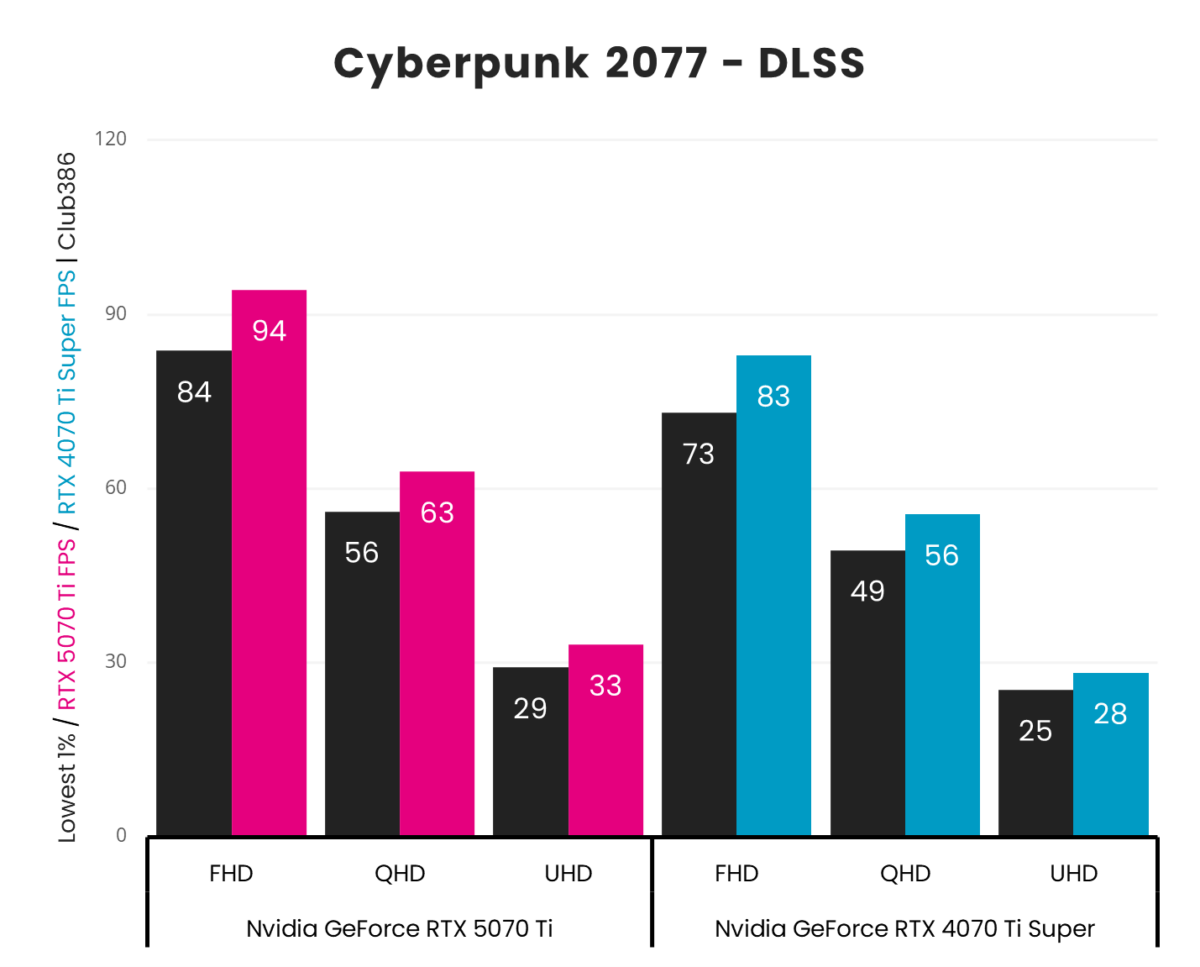
DLSS Super Resolution narrows the gap between GeForce RTX 5070 Ti and 4070 Ti Super to 13% across FHD and QHD. While its generational gains are smaller with upscaling in the mix, the former card does push beyond 60fps at both resolutions unlike the latter.
A playable UHD experience using DLSS in its ‘Quality’ preset is possible with GeForce RTX 5070 Ti but it’s far from an ideal way to play. Dropping to ‘Balanced’ or ‘Performance’ would improve frame rates but at the cost of fidelity. This is a much easier pill to swallow, though, thanks to the image quality improvements of Nvidia’s Transformer model.
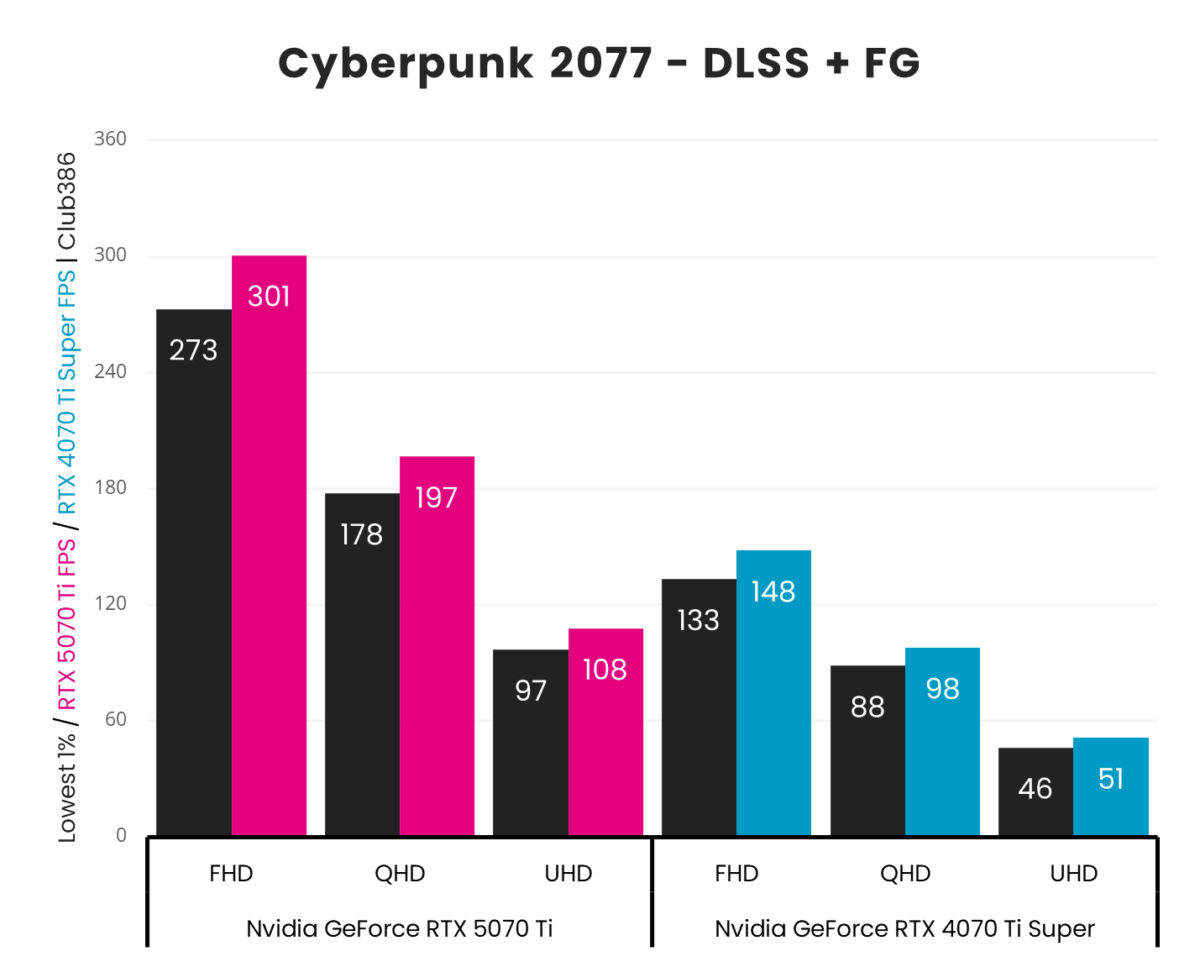
Multi Frame Generation running at x4 catapults GeForce RTX 5070 Ti frame rates into realms that RTX 4070 Ti Super can only dream of with its Single Frame Generation. The feature separates the new from the old by a whopping 104-112% across all three resolutions.
FHD and QHD are the only viable resolutions for Multi Frame Generation using DLSS Quality on GeForce RTX 5070 Ti though, as they’re the only ones with high enough base frame rates to mitigate any latency concerns. Meanwhile, RTX 4070 Ti Super can only realistically cater to FHD and it doesn’t come close to matching the fluidity of its successor’s 301fps.
Vitals
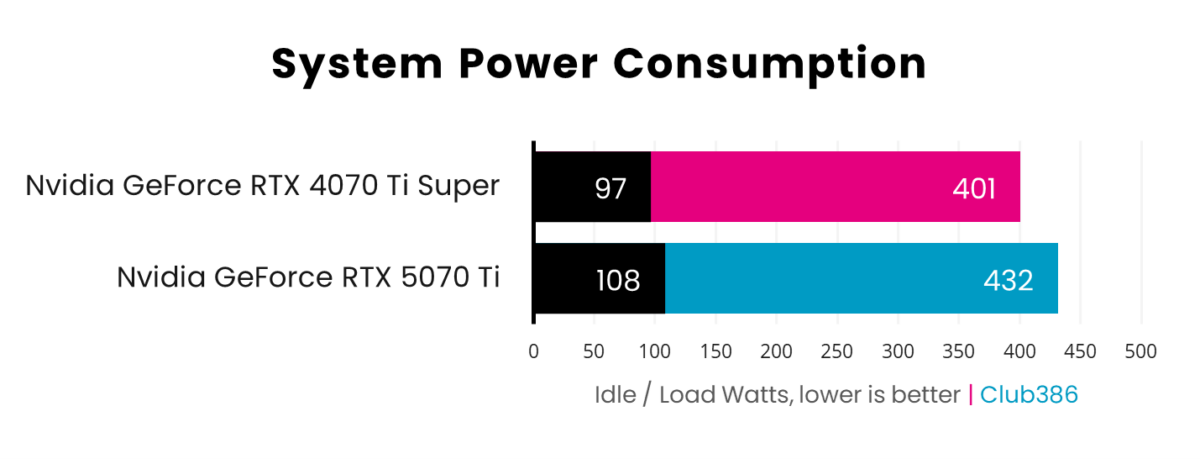
A higher TDP naturally translates into higher power consumption. GeForce RTX 5070 Ti draws 9W more than RTX 4070 Ti Super while idle, growing to 31W under load. These differences aren’t large enough to lose sleep over and are reasonable considering the general performance uplift the hungrier of the cards offers.
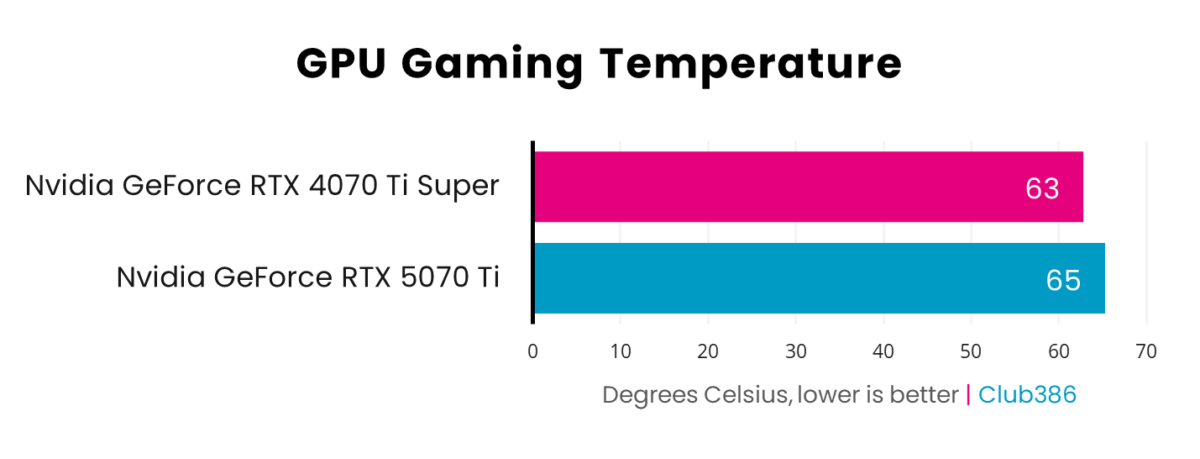
Temperature management will vary by manufacturer for GeForce RTX 5070 Ti and RTX 4070 Ti as there’s no Founders Edition for either model to set a baseline. Thankfully, speaking from experience, the chances of encountering a partner design that isn’t up to the task of providing adequate cooling is extremely low.
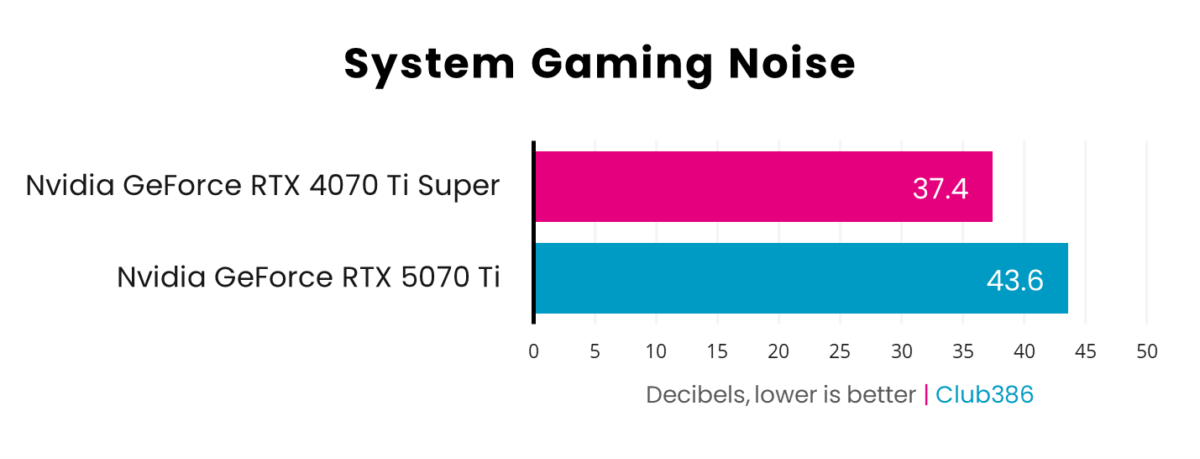
Like cooling, acoustics are also highly variable due to the different ways partners approach their cooler designs. In the case of the decibel measurements above, GeForce RTX 4070 Ti Super wins out despite sporting an almost identical chassis.
Conclusion
Less revolutionary and more iterative, GeForce RTX 5070 Ti still earns its place as a successor to RTX 4070 Ti Super. While its rasterised rendering uplifts aren’t awe inspiring, it does offer far better ray tracing performance in addition to superior deep learning capabilities. That’s not forgetting its support for Multi Frame Generation and ability to run Transformer model DLSS at little cost to frame rates.
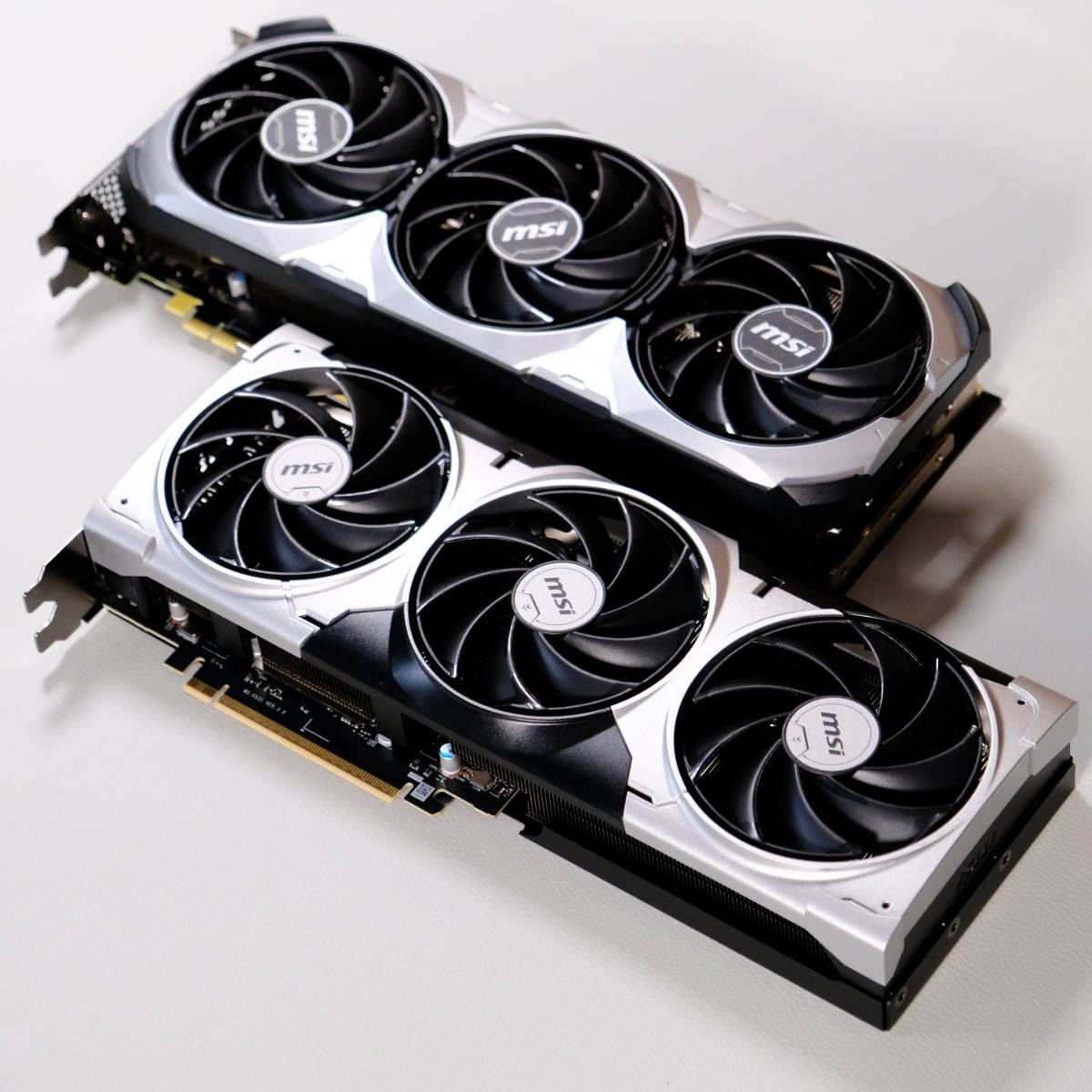
Does GeForce RTX 5070 Ti pack enough value to warrant upgrading from RTX 4070 Ti Super? Not really. Then again, I highly doubt the majority of gamers using the latter card have any intention of upgrading anytime soon anyway with just over a year of use under their belts at most.
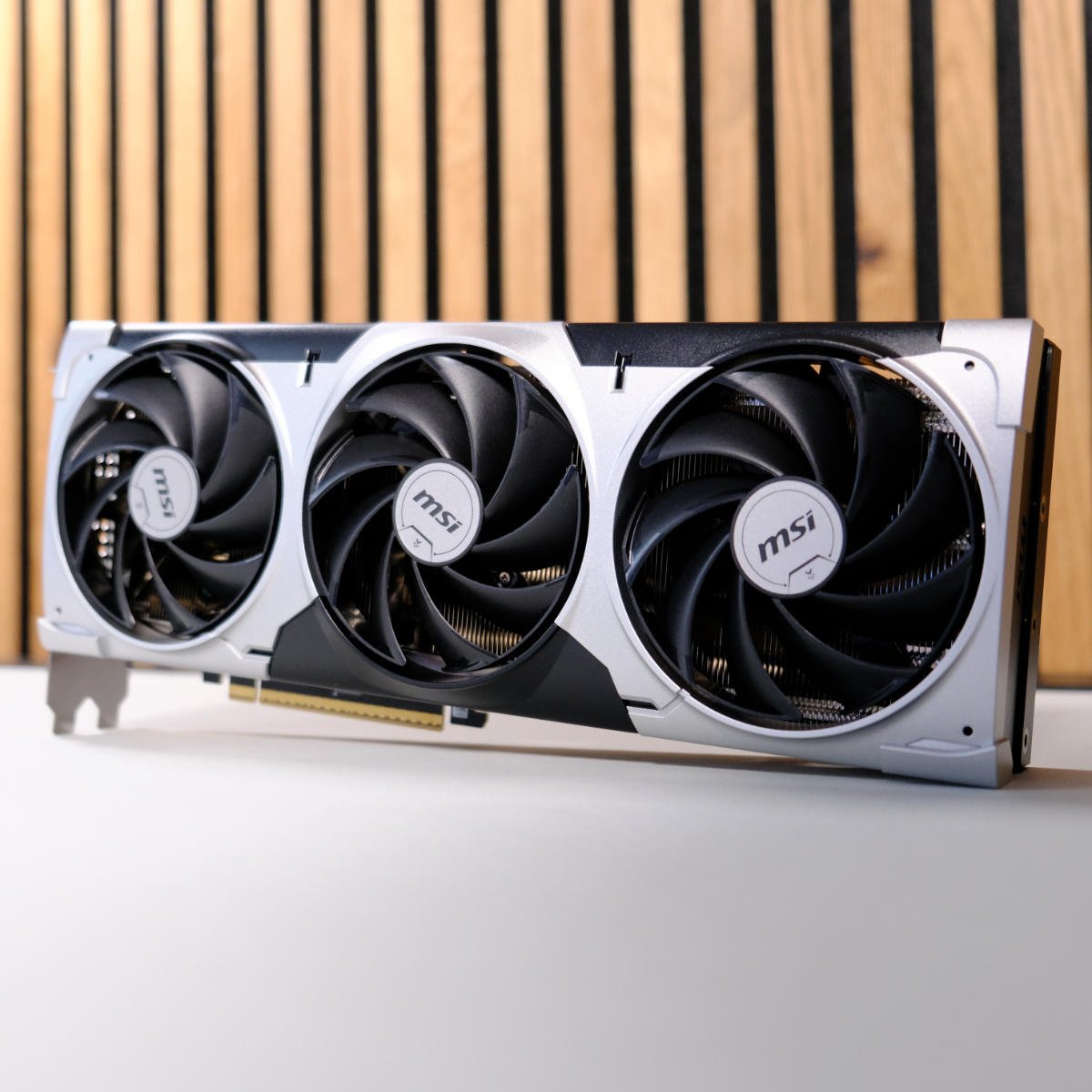
GeForce RTX 5070 Ti
“Transforming Nvidia’s Blackwell GPU range into a trio, MSI GeForce RTX 5070 Ti Ventus 3X promises big things wrapped in its $749 MSRP.” Read our review.
Curious to know how GeForce RTX 5070 Ti fares against Radeon RX 7900 XT? I’ve got good news and another clash of cards just for you.

